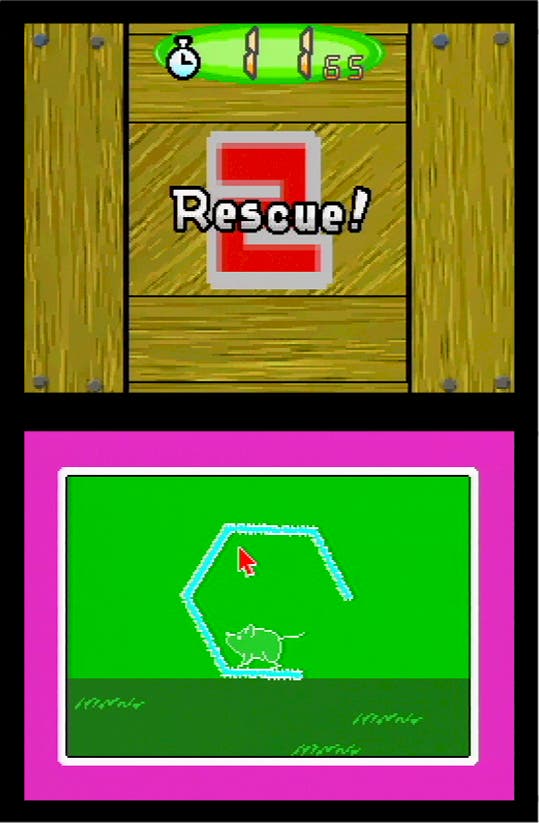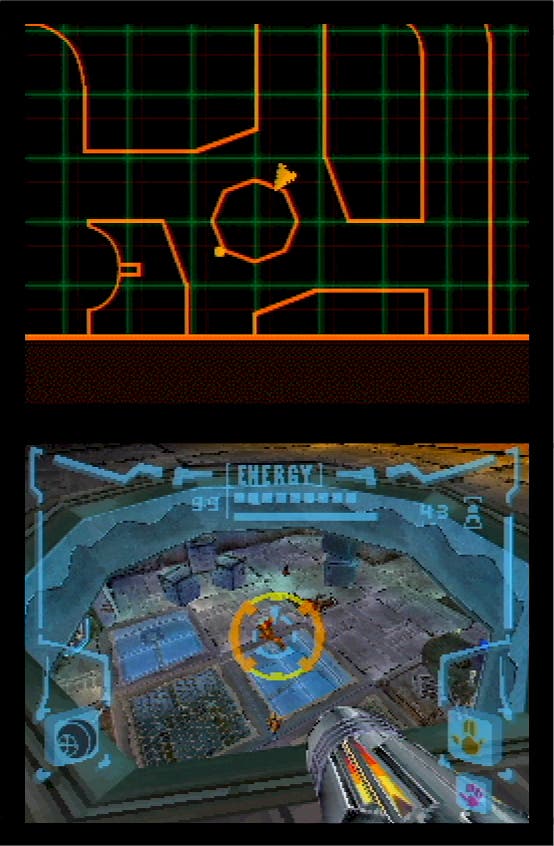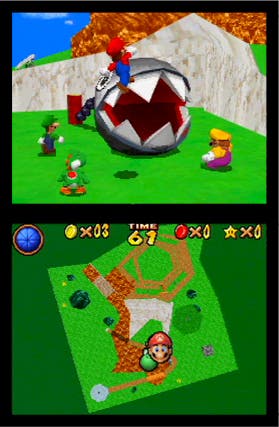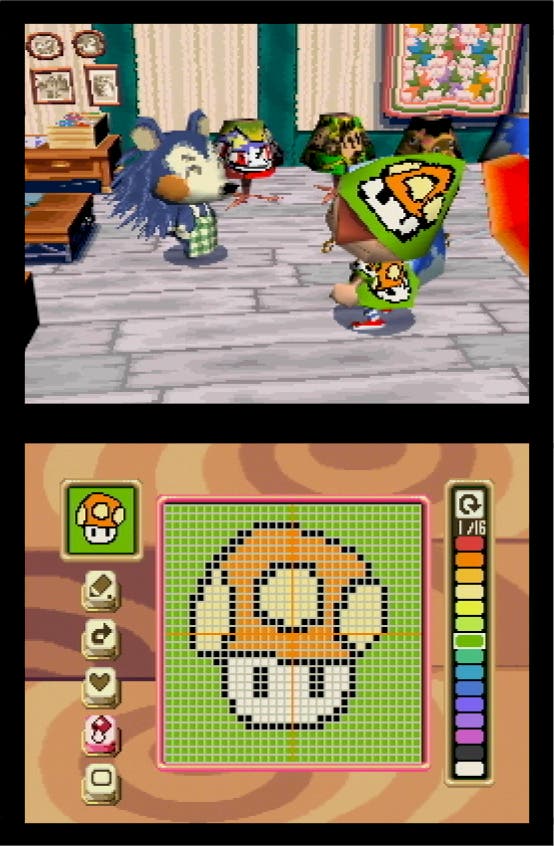Nintendo DS launch demos
Including 20-minute over-the-shoulder video of us getting to grips with the DS for the first time. We consider WarioWare, Metroid, Mario, Bomberman, all the tech demos and more, not to mention the video demos of Animal Crossing, Mario Kart and Mario Bros.
While you're reading our impressions, you might like to head over to Eurofiles where you can now download a 20-minute video shot behind the scenes on the Nintendo stand, which shows us playing around with some of the DS games - many for the very first time. For more information on how to use Eurofiles, click here.
Nintendo wants people to judge the DS based on its software, but for the moment at least any attempt to do so would only paint a fraction of the final picture. Nintendo does claim that many of the demonstration titles we played following the system's unveiling last week are trial versions of complete games, but almost all of them were simply too brief or too abstract to either sell or condemn the system in any meaningful way. As a result, what follows is more of a work in progress - this is how Nintendo sold the system to the world. Whether or not we'll buy into it is a question best left for another time.
WarioWare, Inc. DS (Nintendo)

As something of a bastion of innovation itself, WarioWare, Inc. was an obvious choice for a DS launch title, and the E3 demonstration version was one of the few games on display that truly felt like it belonged on the system. Whereas some of the others felt heavily contrived - presumably in a rush to show us just what the system could do rather than to give us a taste of what we'll actually end up buying - WarioWare translated with striking ease, harnessing the stylus in the same instantly intuitive way its GBA cousin lent on the directional pad and A button. It felt like it could be a real game rather than a demo.
Whether it was scratching Wario's back where he couldn't reach, slicing through oncoming fruit with the stylus, dragging a butterfly net around a swarm of bugs, trying to redraw a symbol shown on the top screen with our stylus, or just rubbing the screen as if it were paper overlaid on a coin to reveal the shape of the object below, it all came remarkably naturally and proved very gratifying after just seconds. It also wisely didn't rely on switching to the D-pad or function buttons for input, as some other games have done - and we can certainly see this one proving a firm favourite with commuters and just about anybody who wants to play for a few minutes on the go. Assuming they actually buy it this time.
In fact, we were almost overcome by our imaginations as we walked away - picturing all manner of scenarios, trying to visualise how Nintendo might harness the console's short and indeed long-range multiplayer facilities to make the best of the title - but the truth is that WarioWare's brilliance lies in its variation and unpredictability, and we're confident that whatever the team produces, it'll be both engaging and different to anything we've dreamt up in the interim. Easily the most promising DS game on the show floor, largely because the game's short, sharp bursts of excitement are perfectly suited to a setting where even the briefest of encounters can be crucially important.
Metroid Prime: Hunters (Nintendo)

Initial reaction to this four-player, deathmatch-oriented first-person shooter focused much more on the visuals than anything else, but a closer examination of how it actually played gave us a little cause for concern. Controlled using a mixture of the directional buttons and the stylus, it's an odd game to play. Although we were pleased to see that someone had the forethought to cater to southpaws by mirroring the forward, back and strafe functions of the D-pad on the diamond opposite (perhaps the reason Nintendo opted for a diamond configuration in the first place, having resisted the temptation to use it on previous handhelds), moving Samus around was often made difficult by the way her gun fires whenever you lift your stylus off the screen.
In a sense then, it consisted of dragging the stylus around to change direction whilst trying to peer down slightly to see over her weapon, which was almost always charging up. Fortunately in combat the shoulder buttons could be used to lock on to an enemy (tapping the screen will obviously fire the gun, one shot per tap), and the morph ball function glimpsed in some of the videos was activated by tapping the button highlighted in the corner of the touch screen, so it wasn't exactly gruelling, but it's not completely flawless either - and you could argue that the fully 3D level stretching over two floors complicated a system that already felt quite awkward.
However, given that the E3 build was likely just a concept and that we only had a few minutes to get used to it, there's still time to tweak the way it works and it's still a very impressive title to have realised on the DS. Visually, as everyone notes, it's undeniably one of the most arresting titles on the format - effectively looking a bit like a post-PSX, early-PS2-level 3D engine decked out with Metroid Prime colours, models and screen furniture and beautifully detailed effects; with a Doom-style top-down wireframe map on the top screen. It's a phenomenal technical achievement. Although we've still yet to see how it works when played wirelessly (the display units were networked together via cabling), and there's no word on a single-player game yet, it's certainly a title with a lot of promise.
Super Mario 64x4 (Nintendo)

Much like Metroid Prime: Hunters, Super Mario 64x4 was a game in much demand at E3 largely because it's been allied to one of Nintendo's most popular properties. It's an approach that certainly worked - 64x4 is not much more than a demonstration of the console's technical prowess in porting its most prominent 3D title onto the smaller unit, and yet the Mario demo consoles were always packed and we had to use our elbows quite viciously in order to get close to one.
Mario 64 was never envisaged as the sort of game you'd play using two screens, let alone a stylus, so the demo on display at E3 did very little to make use of the console's new features. Instead, the touch screen was used for a 2D top down overview, while the bulk of the action took place on the upper screen - where the castle from Mario 64 was lovingly recreated for Mario, Luigi, Princess and Yoshi to frolic around searching for stars. The idea was simply to wait for a star to spawn and then be the first to grab it - the winner being the character with the most stars at the end of a 30-second round.
Visually the game certainly did its job, managing to convey much of the detail that made Mario 64 such an impressive sight on the N64, even borrowing some of its ideas like sprite-based trees with boughs to climb, and transparency effects to stave off 'camera in the wall' issues. On paper, it sounds like the perfect tech demonstration - allowing players to run, jump, and even bash each other in a race around a glorious 3D environment to grab stars from platforms, suspended above trees and even lashed to the end of a Chain Chomp. However, much like Metroid Prime, it also exposed possible control issue - in this case the way the analogue control converts rather poorly to the D-pad.
Moving Mario around wasn't all that difficult, but there was a degree of inertia which felt wrong on a digital D-pad and needs to be reconsidered before we can get on with the controls. Likewise using the shoulder buttons to turn the camera wasn't entirely effective, and felt awkward to do (although we understand the unit design is due a revision, so that may well change). A nice technical demonstration then, but another question mark over the DS' control of traditional 3D games.
Bomberman DS (Hudson Soft)
Whatever the format, Bomberman was always going to be a favourite, and although we certainly spent more time with it than some of the other, newer titles on display in Nintendo's closely guarded DS demo room, that was largely because Bomberman itself is a solid and consistently enjoyable game to play, rather than it doing anything particularly groundbreaking with its unusual hardware. So what was it like? Well, before we even started we were given a taste of how the DS functionality had been lashed on to the game - having to rub the touch screen vigorously to operate a balloon pump. When the time ran down the size of the balloon dictated how many power-ups we began the round with.
At this point the game switched to the familiar screen. Two of them in fact. The top screen was given over to a 3D Bomberman view reminiscent of the single-player console versions, while the touch screen used a much more traditional top-down 2D view with the board leaning slightly away from the player to give it that impression of a third dimension. Control was almost entirely D-pad and A button-based - and obviously the task was to plant bombs to blow holes in rocks, and marshal a variety of power-ups and chain reactions to try and outwit AI-controlled opponents. The only real semblance of a DS element came when a 'ghost' grabbed the player, which had us scrambling to find the stylus again so we could rub it off the screen, often dying in the process.
It's an early demo, naturally, and the multiplayer mode will doubtless be fun whether or not Hudson makes any striking changes to the actual format of the game, but we had kind of hoped for a bit more of the innovation that Nintendo had been banging on about the previous day, and instead we wound up playing a knock-off with a few DS wildcards thrown into the pack.
And The Rest

Other titles on display varied in quality, functionality and the degree to which we even realised what was going on. Square-Enix's Egg Monster Heroes, for example, flummoxed us for a good few minutes (eventually revealing itself as a sort of turn-based RPG with a locational damage system that used the stylus for targeting). However overall there was a feeling that while some developers were clearly not hitting the spot, they were at least thinking outside the realms of gaming cliché.
The Sonic demo, for example, involved changing camera angles with the touch screen and rubbing it quickly to make Sonic run faster through an Adventure-esque 3D environment, whereas Pac-Pix was a stroke of absolute genius - drawing Pac-Man using the stylus and then having your doodled version literally spring to life and race off to chomp ghosts, changing direction whenever you drew a line in front of it. Hats off to Namco for that one.
Even some of the out-and-out tech demos were worthy of note - particularly Submarine, which involved guiding a 3D sub through an underwater environment using various knobs and levers on a touch screen instrument panel - and the PictoChat tool, which, despite our frustrations with the on-screen keyboard (watch our video to see what we mean), is exactly the sort of simple tool that could help transform the DS into far more than a mere handheld games console. It certainly beats the hell out of text messaging.
AWOL

Disappointingly, three of the most intriguing names on the Nintendo DS release list were only on display in video form, and although none of them seemed to be doing anything miraculously innovative with the hardware, the fact that they were based on three of our favourite Nintendo franchises certainly meant we missed their presence at the show. Animal Crossing DS, to begin with, might even have given us a better example of the keyboard tool than PictoChat. In the video we saw, the inventory, keyboard and the design tool used to create custom clothes and hats were all placed on the touch screen for ease of use, and otherwise the visuals were roughly equivalent to the Cube version at a glance, although obviously they lost some of that smooth-edged clarity that made the original such a looker.
We could apply a similar comment to Mario Kart DS, too, which seemed to fall somewhere between MK64 and Double Dash in terms of visuals on the top screen, with an overhead map, track and time information and a real-time list of car positions on the touch screen. From what we saw it moved quite fast, used the Yoshi outline track from Double Dash and included hopping, which ought to make a few people very happy.
The game ambiguously billed as "NEW Super Mario Bros." by its creator, meanwhile, certainly drew its inspiration from Mario Bros. If you imagine the pixelated, hard-edged, old school Mario Bros. look from the 80s and then give it a higher resolution and elements of 3D you won't be far off. At first glance it hasn't changed much, but look closer and you can see Mario flipping acrobatically in 3D. A bit later on he comes up against a Goomba who swallows his mushroom, growing in size until it dwarves the portly red plumber and he has to flee. Not for long though, because he can also reach that size - growing seamlessly to literally fill the whole top screen with a big 3D model, before racing along and stomping on all sorts of enemies, smashing through block arrangements and head-bopping Bowser to finish. It's-a-him.
Proof of concept
As we've said, although E3 sometimes gives you a very good impression of how a game is going to turn out, more often than not even an hour in a demo's company can prove inconclusive without the right context, and in the case of a new console - particularly one that rejects conventional wisdom in so many areas - we're still in a poor position to make any predictions. It feels like we're being asked to make our minds up based on ideas alone - much as we were when the Dual Screen system was first announced and we had very little to go on. As it was then, a snap judgement here is unlikely to help anybody.
However the E3 showing wasn't for nothing. For Nintendo it was partly an interactive "I told you so," and partly a demonstration of gameplay innovation - and in that respect unlike any other console launch we can recall, or expect to see in the future. Everybody goes into a console product launch expecting to see facts, figures and an abundance of polygons. To have built the DS launch on a platform of ideas rather than technology demos underscores the handheld's commendably inventive focus.
As a result, what follows is a brief rundown of the best and most striking ideas seen at E3, and a general rundown of software (including games appearing in video form only). Some demos exposed potential shortcomings, and many more were raw and undeveloped, but the ideas themselves had infinitely more promise than a high-poly car crash or a showreel of popular brands. While we may not be able to judge the overall likelihood of the DS' success, we certainly like the ideas.
To view the full Nintendo presentation that launched the DS console in Los Angeles, and to look over our shoulder as we played through some of the games for the first time, visit Eurofiles and seek out the videos. For more information on the DS and its games, you can refer to our previous features exploring the console itself and the games announced alongside it.

